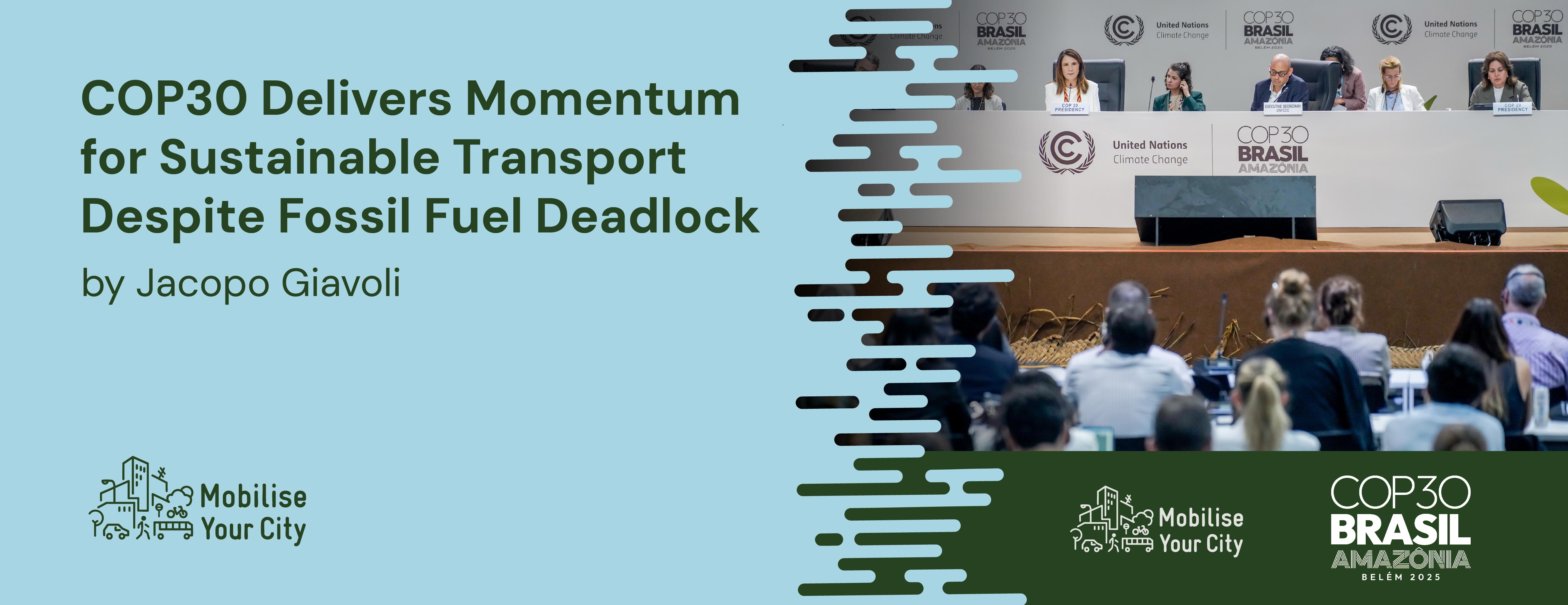COP30 Delivers Momentum for Sustainable Transport Despite Fossil Fuel Deadlock

COP30 concluded last Saturday in Belém after two intensive weeks of negotiations marked by both progress and persistent division. Fossil fuel producing countries succeeded in blocking outcomes that would go beyond the decisions taken in Dubai and Baku. Hopes for clear roadmaps to phase out fossil fuels or halt deforestation were ultimately halted by petrostate opposition.
Yet what was stalled at the political level was partly regained through sector-driven action. The transport sector, one of the hardest to decarbonise, emerged from COP30 with meaningful momentum. The conference delivered tangible advances through voluntary initiatives, enhanced finance mechanisms and, for the first time, a dedicated transport pavilion at a COP summit.
Elevating Transport on the Global Climate Stage
COP30 marked a turning point in how transport is positioned in global climate negotiations. The dedicated transport pavilion, co-organised by Brazil and the SLOCAT Partnership, provided a visible and coordinated platform for the sector. It quickly became a hub for showcasing practical solutions, from bus electrification to infrastructure finance strategies, and for convening high-level dialogue that had previously been scattered across different venues.
This visibility translated into political recognition. After consistent advocacy by UITP, public transport was included in the COP Presidency Action Agenda under Key Objective 13. The timing is crucial: transport accounts for nearly 24 percent of global CO₂ emissions and needs to achieve a 59 percent reduction by 2050, yet rail and public transport currently receive only 23 percent of climate finance. If the pavilion becomes a permanent fixture at future COPs, the sector will finally have both the platform and the recognition needed to close this finance gap and deliver meaningful implementation.
The Global Transport Effort: A Voluntary Benchmark for Action
While formal negotiations lacked binding outcomes, the transport community provided direction of its own. Chile presented a voluntary interim benchmark for 2035 calling for a 25 percent reduction in transport energy demand and a one-third share of renewables, aligned with the International Energy Agency’s Net Zero roadmap. Branded as the Global Transport Effort, this declaration offers a shared reference point for ambitious countries.
It is not a negotiated or prescriptive plan; it is a signal of intent. Supported by ten countries, Chile, Brazil, Honduras, Colombia, Dominican Republic, Spain, Portugal, Norway, Slovenia and Costa Rica, and led by Chilean Transport Minister Juan Carlos Muñoz with strong backing from Brazil, the initiative creates space for frontrunners to move ahead and encourages others to align.
Progress in NDC Integration
Movement was also visible in national commitments. UITP’s analysis of the latest NDCs shows that three-quarters now include public transport measures, up from two-thirds previously. Half of the new NDCs contain specific sector targets, a significant increase from the last round’s 20 percent. This reflects growing acknowledgement that public transport is essential for meeting climate goals.
However, finance remains a weak link. Nearly two-thirds of NDCs do not specify budgets for public transport measures, making it difficult to connect plans with international finance mechanisms, including those under Article 6 of the Paris Agreement.
Finance: Unlocking and Scaling Support for the Transition
At COP30, countries agreed to triple funding for climate adaptation by 2035, signalling that resilience can no longer be postponed. For transport, this means supporting a fair shift to cleaner mobility as electric vehicles and charging infrastructure become unavoidable. Ensuring that workers, communities and small operators are not left behind is now a central expectation.
A key discussion throughout the COP was how to unlock more funding for low-carbon transport, especially public transport systems struggling with chronic underinvestment. Carbon markets were presented as one of the most practical tools. If designed well, accessible to cities, environmentally credible and based on simple, transparent rules, carbon credits can help make projects such as electric buses, metro expansions or cycling networks financially viable.
The Paris Agreement enables two complementary routes. Article 6.2 allows countries and cities to cooperate directly to generate and sell emission reductions. Article 6.4 establishes a UN-supervised carbon market where public and private actors can earn certified credits. Both mechanisms can reduce investment risks and attract new finance. COP30 also opened a new discussion on how global trade policies can support or hinder climate action. This broadens the financial conversation beyond traditional climate institutions.
Looking Forward: A Decade of Implementation
The period from 2026 to 2035 will be the UN Decade of Sustainable Transport, offering a rare opportunity to turn global commitments into concrete progress. It coincides with what many call the decisive electric decade, when countries will set the pace of electric vehicle uptake, build charging networks and lock in long-term technology pathways.
For transport, this decade is a chance to move from scattered pilot projects to large-scale and coordinated implementation, supported by clearer roadmaps such as the TAFF process and the Global Transport Effort. Success will depend on aligning national planning, finance mechanisms and international support.
COP30 did not deliver the long-awaited fossil fuel phase-out plan. But it did provide tools, political momentum and new platforms for transport. The task now is implementation, not new promises. With stronger financing pathways and growing political will, the sector has a foundation to accelerate real and measurable change. If countries seize this moment, the next decade could become the turning point for a truly low-carbon mobility system.